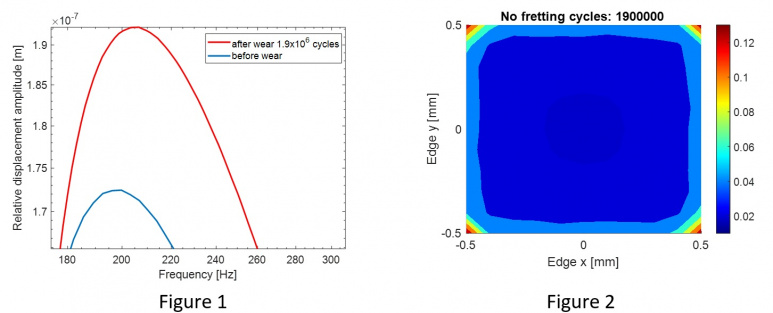ESR2 - Multi-physics reduction approach for nonlinear complex interfaces
Recruiting Institution/Company: Ecole Centrale de Lyon (France)
PhD awarded by: Ecole Centrale de Lyon (France)
Dry friction in contact interfaces can significantly impact the dynamic response of jointed structures when subjected to high excitation levels. One of the most significant phenomena occurring at the interfaces is the fretting-wear. This phenomenon refers to oscillatory relative displacements of small amplitude between two contacting surfaces. One of the main reasons for the complexity in modelling a tribological interface under dynamic loading is that friction and wear problems are multi-scale and multi-physical by nature.
The evolution of wear occurs on a micro-scale level, over a long period, deteriorating the contact surface geometry by producing wear debris through material removal and dissipating energy. Therefore, the worn geometry can affect the dynamic response of the whole system over time. As a result, fretting-wear is often one of the most critical damages in industrial applications.
Fretting-wear is encountered in many industrial contexts where vibrations occur, including the surfaces between root-blade and slot-disk, shroud contacts and bolted flange joints, friction dampers under platform, gears, bearing, and dovetail joints. Thus, the understanding and the prediction of the wear effects on dynamics is necessary for the manufacturers to estimate the performance and for economically improving the design standards.
This work aims at developing and implementing a multi-scale approach to model interfaces under complex dynamic loadings to predict the effect of wear on the dynamics and the evolution of the contact interface. The added value is mainly in the comparison between experiments and updated simulations.
Due to the high costs of a full-scale experimental observation, the design of simplified experimental setups is indispensable for reproducing the configurations of the industrial components at a laboratory scale.
The vibratory test rig [1], built in the Dynamic group of Imperial College London, reproduces the dynamic behaviour observed in friction dampers. It may be useful for giving a detailed frictional description of the contacting interfaces to allow more accurate modelling of these components.
After a reduction of the size of the problems, using a component mode synthesis reduction strategy, the non-linear forced response is evaluated using the Harmonic Balance Method (HBM) coupled with the Dynamics Lagrangian Frequency-Time scheme (DLFT) developed by Nacivet et al [2]. Wear is automatically considered during the non-linear analysis, using the Archard model over one vibration cycle.
A multi-scale approach is implemented considering two time scales: a slow-scale for wear phenomena and a fast-scale for dynamics and applied to validate the experimental test described in [1]. Therefore, to decrease the computational time and the number of iterations, a jump cycle strategy is implemented, assuming the wear rate to be constant for a certain number of vibration cycles, previously chosen [3]. The worn profile computed is then used to update the geometry in the HBM and evaluate the wear evolution and its effect on dynamics.
In the vibratory test rig example, the numerical results [4] appear to be in good agreement with experiments. In term of dynamics, Figure 1 shows the tendency of the resonance frequency to increase with wear. In term of wear pattern, Figure 2 shows how the phenomenology is quite well respected with the maximum amplitude in the corners.

The proposed numerical method based on DLFT allows to calculate simultaneously the vibrational behaviour and the wear evolution in fretting-wear problems. Moreover, considering harmonic solutions and reducing the problems in terms of relative displacements as well as the adoption of a jump cycles strategy for updating wear, allow an important reduction of the computational time.
The development of numerical tools embedding wear can give to the manufacturers more detailed description about the wear distribution and the local friction behaviour.
[1] A. Fantetti, L.R. Tamatam, M. Volvert, I. Lawal, L. Liu, L. Salles, M.R.W. Brake, C.W. Schwingshackl, D.Nowell, Thimpact of fretting wear on structural dynamics: Experiment and Simulation, Tribology International, Volume 138, pp. 111-124, (2019).
[2] S. Nacivet, C. Pierre, F. Thouverez and L. Jezequel, A dynamic Lagrangian frequency-time method for the vibration of dry-friction damped systems. Journal of Sound and Vibration 265, pp. 201-219, (2003).
[3] Salles, L., Blanc, L., Thouverez, F., Gouskov, A.M., Jean, P.: Dynamic analysis of a bladed disk with friction and fretting-wear in blade attachments. In: ASME Turbo Expo 2009: Power for Land, Sea, and Air, pp. 465–476. American Society of Mechanical Engineers, New York, (2009).
[4] F. Tubita, A. Fantetti, L. Blanc and F. Thouverez. Effect of fretting-wear on dynamic analysis. Comparison between experimental results and numerical simulations for a vibratory friction rig. IX International. Conference on Computational Methods for Coupled Problems in Science and Engineering COUPLED Conference Proceedings (accepted paper Proceedings)
